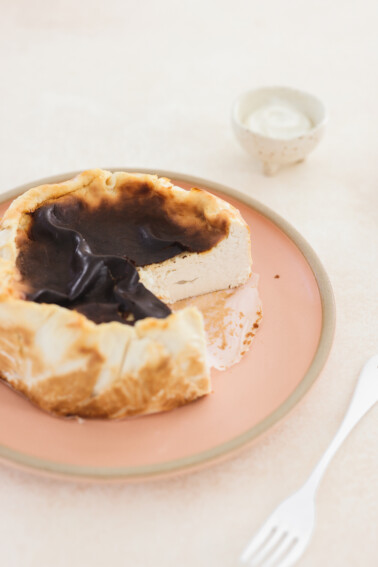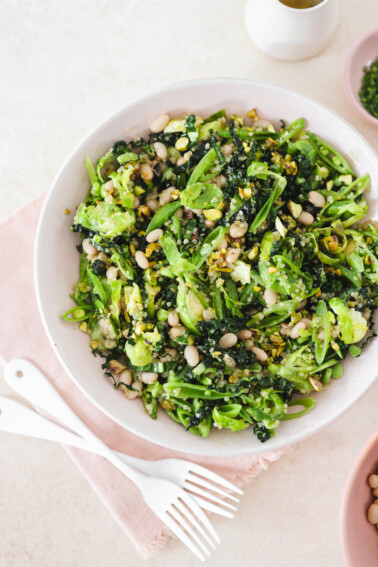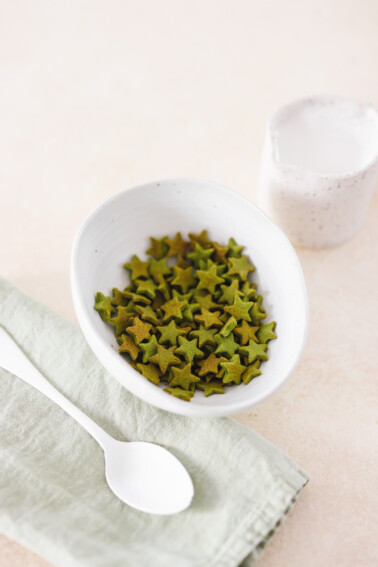This page may contain affiliate links, which means I will make a small commission for products purchased through my link.
A delicious, vegan take on poke bowls. This nutrient-dense, plant-powered Vegan Poke Bowl recipe is gluten-free, packed with plant protein, and easy to make!
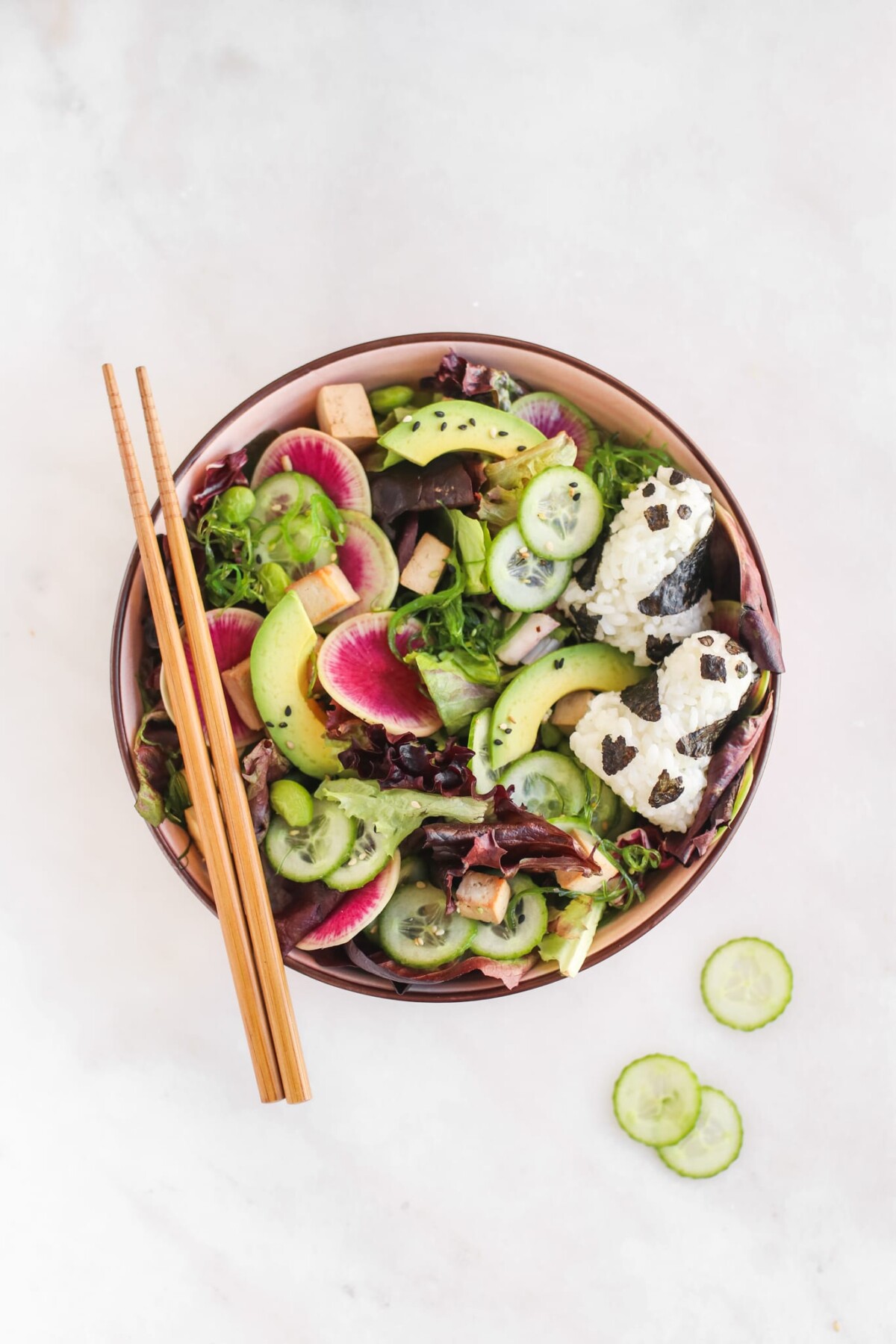
What is a Classic Poké Bowl?
A poke bowl is a traditional Hawaiian dish featuring diced raw fish, like raw ahi tuna or salmon, marinated in a sauce with ingredients such as soy sauce, sesame oil, ginger, and garlic. It’s served over a bed of rice or greens and topped with a variety of vegetables like avocado slices, cucumber, seaweed, and more.
Popular for its fresh flavors, poke bowls are customizable and often include additional condiments like soy sauce, spicy mayo, or wasabi on the side.
What Makes This Recipe Great
This vibrant, delicious Vegan Poke Bowl is a perfect (and tasty) way to get lots of veggies in for the day. Inspired by Hawaiian poke bowls, which are traditionally made with fish, I’ve partnered with Earthbound Farm to play up the fresh flavors of plants in an all-vegan version.
Typically, traditional poke bowls are made with a base of white rice and/or greens, raw fish protein, and Japanese ingredients like pickled cucumbers, seaweed salad, and edamame. We’ll be using all the above, plus some pops of pink with Earthbound Farm’s Organic Rosé Blend and watermelon radish.
These plant-based, tofu poke bowls are a treat for the tummy and the eyes, and the best part is it’s also a very balanced and nutrient-dense meal. Perfect for lunch, dinner, or entertaining–you can really customize these bowls to your liking. If this is your first time making these, get ready for such a treat!
Ingredient Notes
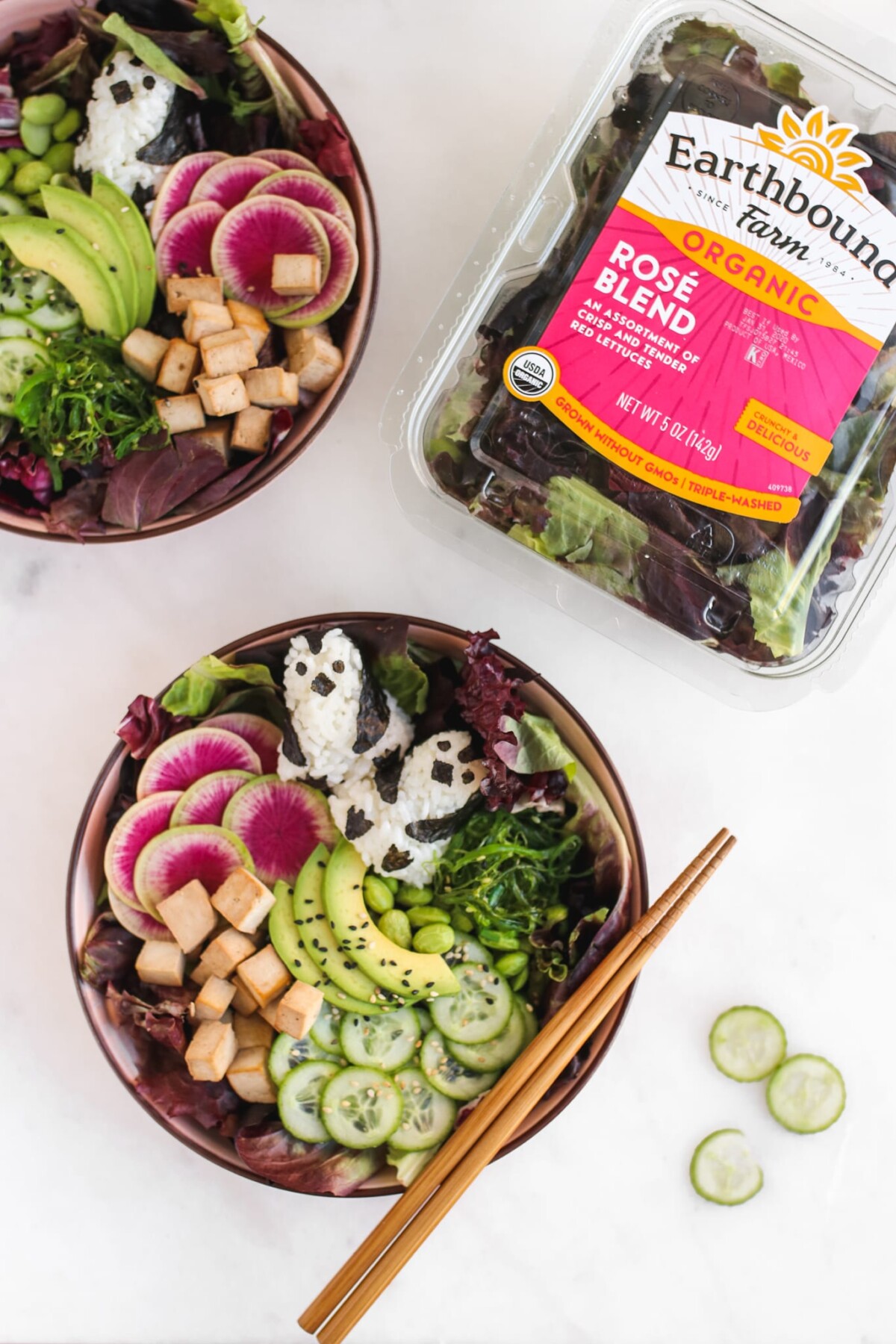
- Earthbound Farm Rosé Blend → I mentioned earlier, contains a mix of organic baby butter lettuce, organic baby oak leaf, organic baby pakchoi, organic baby red leaf, and organic radicchio. The result is a gorgeous, rose-toned blend of tender veg. You can DIY and re-create this mix if you’d like, or choose a salad blend of your liking.
- Pan-fried tofu → is our chosen vegan option for protein! You can opt for your favorite marinated tofu or try the simple 5-minute prep suggestion in the recipe card below. Tofu is high in plant protein, magnesium, calcium, and even zinc! I recommend using extra firm tofu cut into 1 inch cubes.
- Shelled edamame beans → another boost of plant protein and a quintessential Japanese ingredient. These fun beans can be purchased frozen, pre-shelled, or purchased in a pod, boiled, and then shelled by hand.
- Wakame salad → is a flavourful salad made of seasoned wakame (which is seaweed or kelp). It is usually seasoned with sesame oil, sesame seeds, and a touch of sweetness for balance and can be found at most Japanese grocery stores or Asian grocery stores. Wakame is nutrient-rich and contains iodine, iron, and vitamins A, C, E, and K, to name a few.
- Watermelon radish → gives our salad a fun pop of pink. It’s a great source of vitamin C and fiber, but unfortunately, it does not taste like watermelon. It has a mildly bitter flavor, and is best enjoyed when (very) thinly sliced with a mandolin. Any radish will do if you don’t have access to this variety.
- Quick pickled Japanese cucumber → Like the watermelon radish, I like to use a mandolin to make super thin cucumber slices. Mini cucumbers work best, in my opinion, and you can either enjoy them as is or quickly pickled (see notes below!).
- Avocado → need I say much more? This source of healthy fat is a wonderful complement to almost any salad in the game. PLUS, it helps the body absorb nutrients from all the vegetables, too.
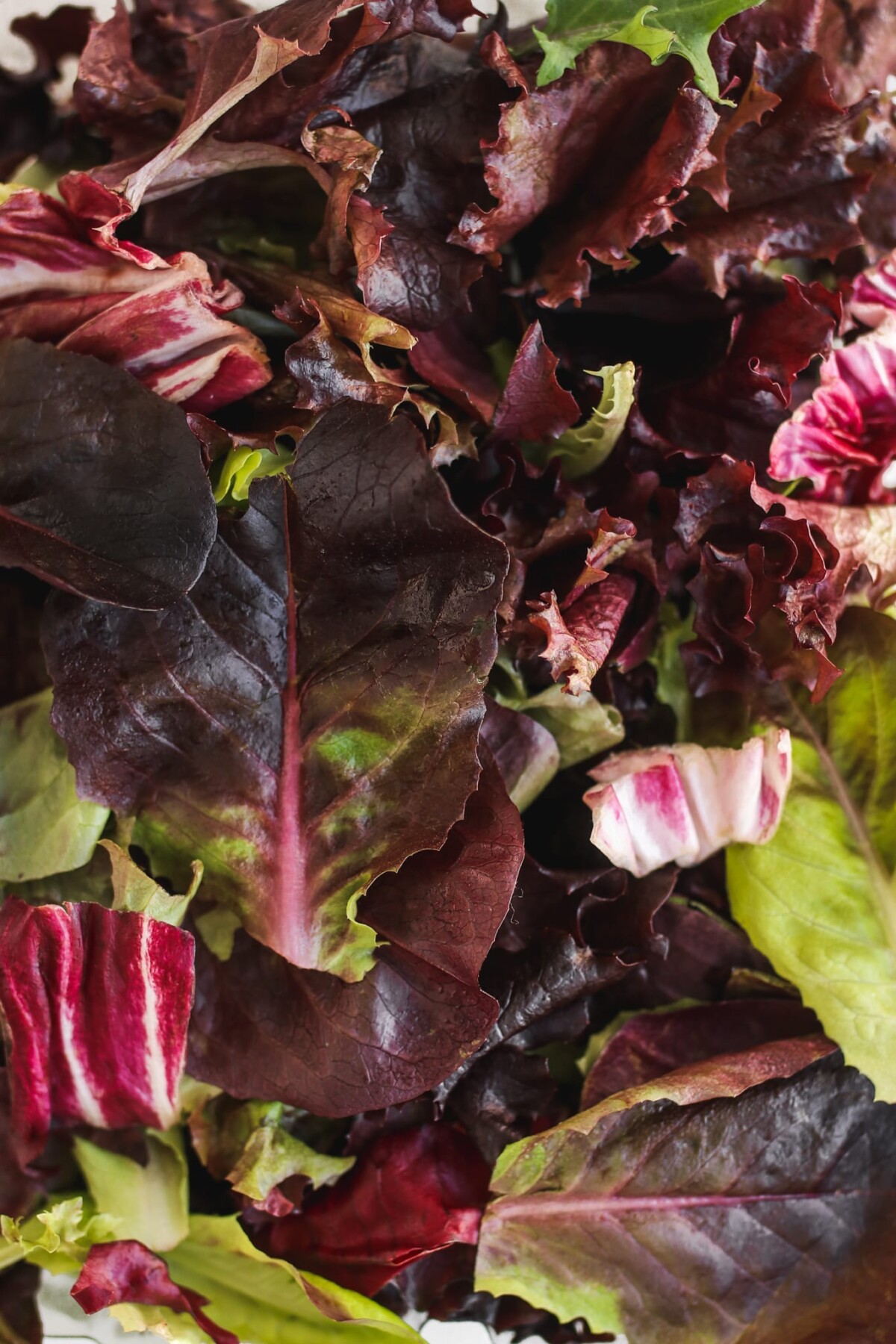
Step-by-Step Instructions
- To quickly pickle cucumbers, thinly slice a mini cucumber with a mandolin and add to a small bowl with a pinch of salt. Let sit, and wait until the juices of the cucumber release (roughly 10 minutes) while you prep your other ingredients. In another small bowl, mix together a splash of gluten-free soy sauce, toasted sesame oil, rice vinegar, and coconut sugar. After your cucumbers release liquid, squeeze out excess liquid and then add your sauce mixture to the cucumbers.
- In a frying pan over medium heat, cook cubed tofu with gluten-free soy sauce and minced garlic. Using a spatula, make sure all sides of the tofu cubes are exposed to the frying pan and cook until all of the sauce is absorbed and the tofu is golden brown. Set aside.
- Assemble bowls, starting with a base of salad and rice if using. Add remaining toppings, and garnish with green onions, sesame seeds, and nori if desired. Serve with sauce on the side if desired. To spice it up, add a spicy sauce like sriracha if desired.
- (Optional step) To prepare penguin rice balls, prepare short grain, white sushi rice according to package directions. It’s typically best to use a rice cooker for best results, and you want to work with rice when it’s fresh. Once cooked, scoop out a cup or 2 and let cool down closer to room temp. Cut seaweed shapes for penguin rice balls or another animal shape of your choice. Use plain sheets of sushi nori and kitchen scissors. Using slightly damp hands, form rice balls using about 2-3 tbsp of cooked and cooled rice. Press firmly so that rice balls are tightly packed, but do not squish the rice too much
(If you break the grains, they will turn into mush.)
Stick seaweed pieces onto rice balls, the rough side of the seaweed down. It should stick easily to the rice, but you can add a touch of water to the backside of seaweed pieces if not.
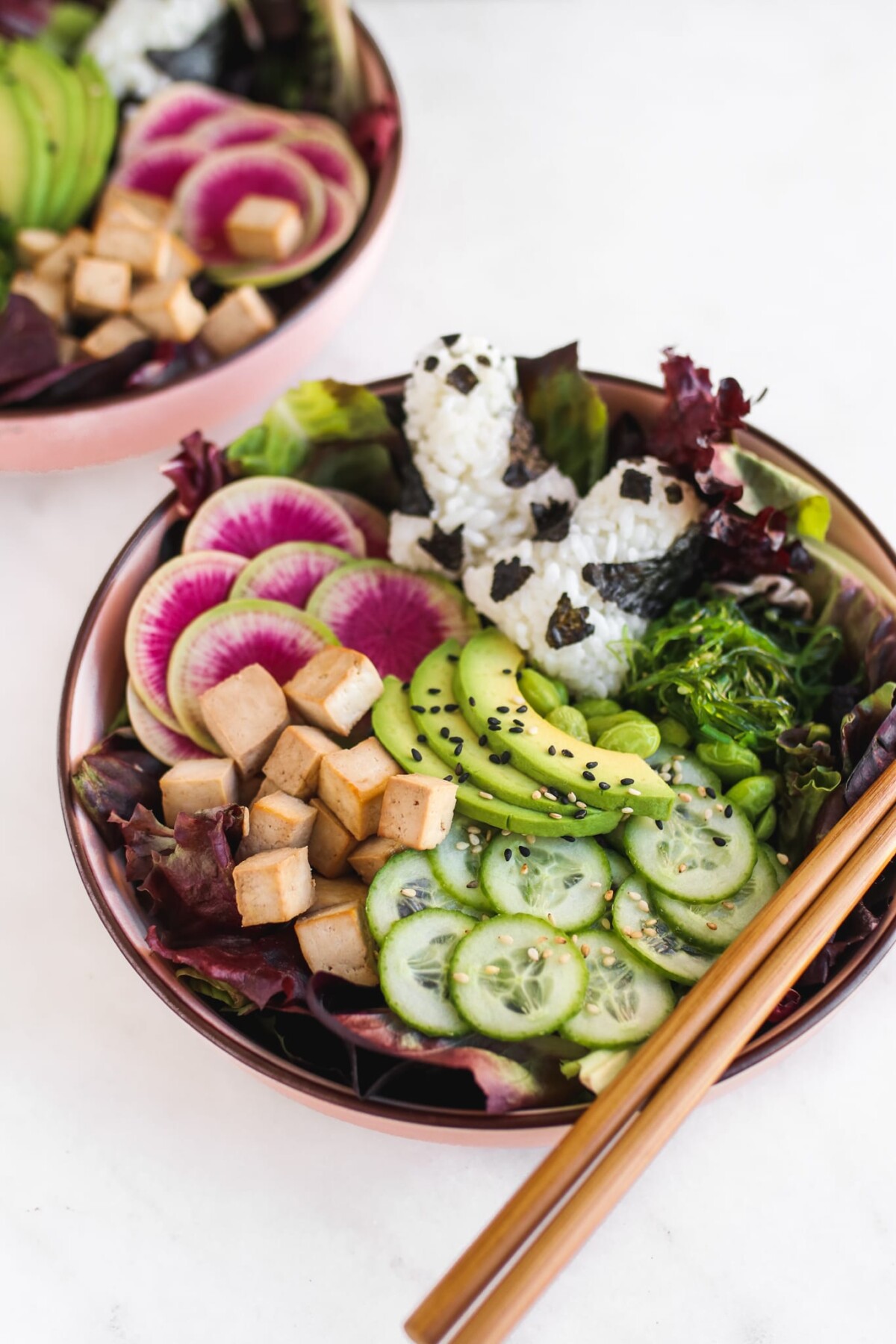
Secrets to Success
- The steps to making these poké bowls are actually very straightforward. For the most part, we’re simply assembling everything into bowls. How you do that is completely up to you! When cooking for friends, I like to group toppings together and arrange them atop the salad base, but when eating at home, I honestly just toss it all into a bowl. It’s best to mix it up before eating anyway for the perfect bite each forkfull!
- Feel free to add additional toppings and veggies of choice to your dish. Carrots, corn, red cabbage, and other plant-based protein like chickpeas or beans would also work. For more heartiness, you can add brown rice or quinoa as well.
- To prep your tofu, I recommend a quick pan-fry with seasoning of choice, but you can also choose to bake it in the oven if you prefer.
- If you’re interested in quick pickling your cucumbers, you can follow this simple recipe. I personally like to use a gluten-free soy sauce and coconut sugar.
- And finally, to season your bowl, you can drizzle a sauce on top for extra flavor. My personal favorite combo is a mix of gluten-free soy sauce (Tamari), rice wine vinegar, and a touch of toasted sesame oil. You can play around to find the combos you like or refer to the recipe notes. You can also add spicy sriracha sauce to kick it up a notch.
Storage Tips
This vegan poke bowl is best eaten right away, but if you want to meal prep and store for later use, store the veggies, sauce, and tofu in separate airtight containers, then assemble when ready to eat.
I recommend storing leftovers in an airtight container in the refrigerator and eating with 24-48 hours for optimal freshness.
More Delicious Recipes
Japanese Sweet Red Bean + Mochi Soup
Gluten Free Zaru Soba (Cold Buckwheat Noodles)
If you try this vegan poke bowl recipe out, tag me on Instagram @veggiekins so I can see your delicious re-creations and for a chance to be featured! As always, I love when you share your reviews in the comments below, and if you make any fun substitutions, let me know how it worked out below too!
This post may contain affiliate links.
Garden Vegan Poke Bowl with Tofu & Watermelon Radish
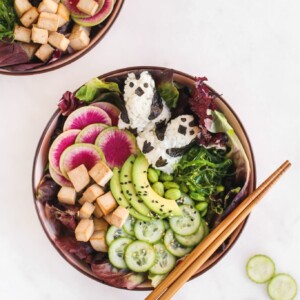
Ingredients
- ½ package Earthbound Farm Organic Rose Blend or roughly 3oz of your favourite salad blend
- ⅓ cup cooked short grain rice optional
- ½ cup extra firm tofu cubed*
- ½ ripe avocado diced
- ½ medium watermelon radish thinly sliced
- 1 mini cucumber thinly sliced (quick pickled if you’d like)
- ¼ cup wakame salad
- ⅓ cup shelled edamame beans
- Sauce optional
- ¼ cup gluten-free soy sauce
- 2 tsp toasted sesame oil
- splash of rice wine vinegar
- Garnish
- sliced green onion
- toasted black and white sesame seeds
- shredded nori
Instructions
- To quick pickle cucumbers, thinly slice a mini cucumber with a mandolin and add to a small bowl with a pinch of salt. Let sit, and wait until the juices of the cucumber release (roughly 10 minutes) while you prep your other ingredients. In another small bowl, mix together a splash of gluten-free soy sauce, toasted sesame oil, rice vinegar and coconut sugar. After your cucumbers release liquid, squeeze out excess liquid and then add your sauce mixture to cucumbers.
- In a frying pan over medium heat, cook cubed tofu with gluten-free soy sauce and minced garlic. Using a spatula, make sure all sides of the tofu cubes are exposed to the frying pan and cook until all of the sauce is absorbed and the tofu is golden brown. Set aside.
- Assemble bowls, starting with a base of salad and rice if using. Add remaining toppings, and garnish with green onion, sesame seeds and nori if desired. Serve with sauce on the side if desired.
- (Optional step) To prepare penguin rice balls, prepare short grain, white sushi rice according to package directions. It's typically best to use a rice cooker for best results, and you want to work with rice when it's fresh. Once cooked, scoop out a cup or 2 and let cool down, closer to room temp. Cut seaweed shapes for penguin rice balls, or other animal shape of your choice. Use plain sheets of sushi nori and kitchen scissors. Using slightly damp hands, form rice balls using about 2-3 tbsp of cooked and cooled rice. Press firmly so that rice balls are tightly packed, but do not squish the rice too much (if you break the grains it will turn into mush). Stick seaweed pieces onto rice balls, rough side of the seaweed down. It should stick easily to the rice, but you can add a touch of water to the backside of seaweed pieces if not.
Notes
Secrets to Success
- The steps to making these poké bowls are actually very straightforward. For the most part, we’re simply assembling everything into bowls. How you do that is completely up to you! When cooking for friends, I like to group toppings together and arrange them atop the salad base, but when eating at home, I honestly just toss it all into a bowl. It’s best to mix it up before eating anyway for the perfect bite each forkfull!
- Feel free to add additional toppings and veggies of choice to your dish. Carrots, corn, red cabbage, and other plant-based protein like chickpeas or beans would also work. For more heartiness, you can add brown rice or quinoa as well.
- To prep your tofu, I recommend a quick pan-fry with seasoning of choice, but you can also choose to bake it in the oven if you prefer.
- If you’re interested in quick pickling your cucumbers, you can follow this simple recipe. I personally like to use a gluten-free soy sauce and coconut sugar.
- And finally, to season your bowl, you can drizzle a sauce on top for extra flavor. My personal favorite combo is a mix of gluten-free soy sauce (Tamari), rice wine vinegar, and a touch of toasted sesame oil. You can play around to find the combos you like or refer to the recipe notes. You can also add spicy sriracha sauce to kick it up a notch.
Storage Tips
This vegan poke bowl is best eaten right away, but if you want to meal prep and store for later use, store the veggies, sauce, and tofu in separate airtight containers, then assemble when ready to eat. I recommend storing leftovers in an airtight container in the refrigerator and eating with 24-48 hours for optimal freshness.Nutrition information is automatically calculated, so should only be used as an approximation.

